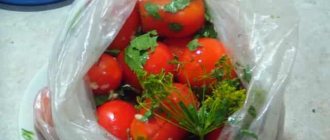12/03/2018Category: Products: cleaning and storageAuthor: navseruki
Some recipes call for using only tomato pulp. It happens that people only eat tomatoes without the peel. If it is necessary to remove seeds and skins from tomatoes, even an experienced housewife can become confused. Let's take a closer look at the popular methods of cleaning tomatoes to determine which one is suitable for the situation.
- 2 Peeling using boiling water
- 3 Peel tomatoes in the microwave
- 4 Separating tomato peels using a gas torch
- 5 Peeling tomatoes with a knife without heat treatment
5.1 Video: a special tomato knife in action
Criteria for choosing a tomato cleaning method
When choosing a cleaning method, it is recommended to pay attention to the following nuances:
- quantity of vegetables - over one kilogram of tomatoes is more convenient to peel in batches using heat treatment;
- degree of ripeness - the peel of unripe tomatoes is worse, and it is more difficult to separate it with a knife;
- The purpose of peeling tomatoes is the need to preserve the shape of vegetables, for example in a salad, requires careful peeling. Whereas tomatoes, peeled in any way, are suitable for making ketchup.
How to properly use boiling water when peeling tomatoes?
To peel tomatoes in a few seconds and in large quantities at once, you need to prepare two bowls - one with boiling water and one with ice water (even adding a few ice cubes is allowed). The manipulation is carried out according to the following scheme:
- We make small cross-shaped cuts on both sides of the tomatoes with a very sharp knife. You only need to use the skin, being careful not to damage the flesh.
- Place the vegetables in a container with boiling water and leave for 20-30 seconds. If the products are not very ripe, then the holding time can be increased to a minute, after which they will begin to cook.
- As soon as the cut edges of the skin are wrapped, we take out the fruits. Then we transfer them to ice water for just a few seconds.
- We drain the liquid and begin to remove the skin. Vegetables should not be left in cold water; their taste and texture will change.
We recommend: How to germinate an orange seed: step-by-step instructions.
If all stages of manipulation were carried out correctly, then the skin can be easily removed with the blunt side of a knife. If difficulties arise with cleaning, the procedure can be repeated.
Peeling using boiling water
This method is suitable if you quickly need to peel several tomatoes. Algorithm of actions:
- Wash the vegetables and cut their peel crosswise in the part opposite the stalk. Try not to touch the flesh too much.
- Place the tomatoes in a bowl and place it in the sink.
- Bring the water in the kettle to a boil. The kettle is convenient to use due to its spout and the ability to pour water with one hand.
- Direct a stream of boiling water onto the tomatoes in the sink, holding each vegetable for at least ten seconds.
- Separate the skin from the tomato; if this is difficult to do, pour boiling water over it again.
The peduncle is the part of the plant that connects the fruit to the stem.
The peel of tomatoes scalded by this method comes off well, but unevenly. You can do it in another way:
- Make 1-2 cross-shaped cuts on the washed tomatoes, without catching the pulp.
- Fill a bowl with boiling water and place a few vegetables in it so that they float freely in the container.
- After 25-30 seconds, remove the tomatoes with the skin curled up at the edges of the cuts. If the skin does not peel well due to insufficient ripeness of the vegetable, you can leave it for another half a minute. It is not recommended to cook longer, as the tomatoes will start to cook.
- Place the tomatoes removed from boiling water into ice water for 10–15 seconds. Vegetables left in the cold longer than this time will become tasteless. Then you need to drain the liquid and start peeling the tomatoes with the blunt side of a knife.
The temperature contrast will make it easier to separate the skins from the tomatoes.
Tip: if you need to maintain the shape of a vegetable, it is better to take tomatoes of medium ripeness. Overripe ones become deformed in hot water.
Thick tomato soup with feta
This simple recipe will perfectly diversify your usual first courses.
First of all, you need to peel the onion, cut into small cubes and place in a deep frying pan with vegetable oil. Fry the onion until transparent. Meanwhile, peel the tomatoes and chop. Place in a frying pan and simmer for 7-10 minutes, stirring occasionally. Add salt, your favorite spices to taste, a little sugar to tone down the sourness. Pour in about a glass of boiling water and simmer for a few more minutes. Remove from heat and use an immersion blender to blend the soup until smooth. Top the soup with feta cheese before serving. Bon appetit!
Source
Many recipes for cooking with tomatoes recommend peeling them. Sometimes this is required to comply with the cooking technology. Sometimes it is explained by the harmful effects of tomato peels on human digestion and health.
There are directly opposite opinions about the harm or benefit of eating unpeeled tomatoes, so it is better to focus on taste and aesthetic preferences. Thus, they claim that peeled tomatoes, if consumed raw, have a brighter and richer taste.
Making sauces or gravies from peeled tomatoes makes them more smooth and appetizing. But pieces of separated tomato skin in soup or vegetable stew look ugly and do not improve the appearance of the dish in any way. And the taste sensations, at the same time, are not the best. So, it’s better to peel the tomatoes! The purpose of this article is to tell you how to quickly, and without much difficulty, peel tomatoes.
Peeling Tomatoes in the Microwave
To peel tomatoes using the microwave, you need the following:
- Wash the tomatoes and let them dry.
- Score the skin along the sides, starting and ending an inch from the stem, and place the vegetables on a flat-bottomed plate.
- Place the tomatoes in the microwave for 30 seconds at 600–700 power.
- Tear off the remaining flaps of skin.
It is important to follow the recommended exposure time to high temperatures. Otherwise, the tomatoes may burn or release juice earlier than necessary. You cannot place vegetables in the oven for additional time. If half a minute in the microwave is not enough to easily separate the tomato skin, it is better to help peel it with the blunt side of a knife.
You need to put tomatoes in the microwave on a dish without sides, then the liquid from the peel will evaporate faster and it will be easier to peel the tomato
Vegetables grown in open ground are peeled better than those grown in greenhouses. But if you wish, you can remove the skin from those ripened in the greenhouse, but you will have to spend more effort.
Using fire
Tomatoes peeled this way are only cooked for a few seconds. Thanks to this, they retain most of the vitamins and beneficial microelements. Only large and slightly unripe tomatoes are suitable for this peeling method.
- The washed vegetables are left on the table so that all excess moisture drains from them.
- Then the tomato is pricked with a fork.
- Turn on the gas or electric stove on maximum heat.
- Bring the tomato and hold it over the fire for 15-20 seconds. In this case, you need to constantly rotate the vegetable so that it is evenly exposed to heat.
We suggest you read: Is it possible to wash fur in a washing machine and how to do it correctly
You can remove the skin from vegetables not only on the stove, but also in the microwave. The latter option is popular among housewives, as it allows you to simultaneously process up to 10 tomatoes.
Correct sequence of actions:
- Tomatoes are washed from dirt and wiped with paper towels.
- Use the tip of a knife to make a shallow longitudinal incision.
- Vegetables are placed on a microwave-safe dish or plate.
- The container is placed inside the device.
- Using the control buttons, the maximum power and processing time are set (40 s will be enough).
- Turn on the microwave and wait for a sound signal indicating the completion of the process.
- After this, carefully remove the tomatoes and remove the peeling skin.
Separating tomato peels using a gas torch
In the absence of burners in the house, you can use a gas burner or a fire (outdoors). The main thing is that the fire is open, and not contact, as in electric furnaces. This method of peeling is inconvenient because you have to process each tomato separately. We will need:
- serving fork - a kitchen utensil with two long teeth and a handle - or a regular one, but with a heat-resistant handle;
- safe source of fire;
- tomatoes;
- knife.
Despite the name, these forks are not used for eating, but for setting the table or used in the cooking process.
Procedure:
- Wash the tomatoes.
- Place one tomato on a fork.
- Hold the vegetable over the heat for 20-30 seconds, rotating to ensure even heating.
- As soon as the skin wrinkles, remove the tomato from the heat and begin to separate the peel with a knife - its dull part.
In this method, it is important not to get burned, and the skin will be removed without problems.
Another option is to peel off the peel using steam:
- Boil water in a special double boiler or pan with a metal insert with holes for steam to escape.
- Place the washed and cut tomatoes in the steamer compartment or on the perforated insert.
- If you only want to remove the skins but want to keep the vegetables raw, remove the tomatoes after 35 to 40 seconds.
- Remove loose skin with the dull side of a knife.
Instead of a bulky steamer, some housewives use compact perforated attachments for pans
Tomatoes for the winter (without skin) - you'll lick your fingers
The article is published with the topic: Canned tomatoes for the winter without skin. Peeled tomatoes are of the best quality and renowned chefs appreciate this method of canning.
It gets a little more complicated because you need to peel the tomato. But the fruits you get are delicious, and if you pick them up with your fingers, you’ll end up licking them pleasantly.
Make these tomatoes in your own juice and you will discover the delight of taste.
The process of peeling a tomato does not take much time. The washed tomatoes are placed in a colander and lowered into a pan with hot water at a temperature of 95 degrees C. Leave for 1 - 2 minutes, then quickly removed and, together with the colander, lowered into cold water for 1 - 2 minutes. As a result, the skin can be easily removed by hand or with a knife.
Peeled tomatoes are placed tightly in jars - cut into slices. The peeled tomatoes are placed tightly, without air gaps. And, note, they are not filled with anything else, but they must be sterilized immediately. This is what large tomatoes do for the winter.
Medium-sized and slightly smaller tomatoes are prepared as whole fruits. Peel the skins, put them in jars and fill them with their own tomato juice. Or you can just pour hot brine over it - and that’s a different way of cooking. And then, look at recipes with different ways of preparing them.
We will need:
- Tomatoes with skin - 5.5 kg
- Salt - 1 teaspoon per 1 liter jar
- Sugar - 1 tablespoon per 1 liter jar
- Vinegar 9% - 1 tablespoon per 1 liter jar
Preparing the recipe - tomatoes for the winter:
Make a cross on each tomato to remove the skin later.
Place the cut tomatoes in three bowls and pour boiling water over them for 10 - 15 seconds.
After this procedure, the peel is easily removed from the tomato.
Cut the peeled tomatoes into 4 parts and cut out the stem.
Carefully place the sliced tomatoes into a clean jar. The jar does not need to be sterilized. The slices need to be laid tightly, pressing slightly on them.
Place a heaped teaspoon of salt in a liter jar. Salt should be rock salt. Note that the tomatoes take up a little more than half the jar.
And one heaped tablespoon of sugar.
We continue to place the tomato pieces in the jar to the top.
Thus, fill as many jars as you can manage.
We got 5 liter jars.
Cover the jars with lids and place 3 jars in a pan with a napkin on the bottom.
Pour cold water up to the hangers of the jars and place the pan on the fire. After the water boils, reduce the heat and sterilize the liter jars for 15 minutes.
2 minutes before the end of sterilization, remove the lids and pour one tablespoon of vinegar into each jar and finish cooking.
Then we take the jars with lids out of the water and seal them with a seaming wrench.
This way you need to roll up all the cans.
There is no need to turn the jars upside down, we will simply wrap them and they will stand there until they cool completely.
Here, look at how tomatoes turn out for the winter in their own juice, sliced and without skin.
They keep well even at room temperature and are very tasty.
Tomatoes for the winter - with whole fruits, without skin, in brine
To prepare this recipe, medium-sized red oval or plum-shaped tomatoes are used, as well as small round tomatoes with a diameter of up to 3 - 4 cm.
Preparing tomato juice
Cut large tomatoes into pieces, place in a saucepan and put on fire. Stir, but do not bring to a boil. Then rub the hot mass through a fine sieve. You now have tomato juice for pouring peeled fruits into jars.
Dissolve salt and sugar in tomato juice. Fill the tomatoes in the jars with juice so that the juice level is 2 cm below the edges of the jar. Cover with lids and after the water boils in the pan, keep 1 liter jars for 10 minutes.
Take the jars out of the water and immediately roll them up with a machine.
The recipe for tomatoes for the winter in their own juice with whole fruits without skin is ready.
Preparation:
- We remove the skin from the prepared tomatoes using a method known to us.
- Pour 2 tablespoons of vegetable oil into clean but still empty liter jars to improve the taste.
- Then place the peeled tomatoes in jars with oil.
- Bring the water to a boil and dissolve salt, sugar and citric acid per 1 liter.
- Pour hot brine into jars of tomatoes and pasteurize in a saucepan from the moment of boiling for 10 minutes.
- Remove the jars from the water and immediately roll up the lids.
Peeling tomatoes with a knife without heat treatment
If you don’t have anything on hand other than a regular knife and a cutting board, you can use them to separate the peel:
- Divide the tomato into quarters and carefully cut off the base of the stem from all the pieces.
- Place the tomato quarters, flesh side up, and carefully begin scraping them from the skins on the board.
The method is labor-intensive and suitable for those who have a lot of free time and plans to further chop tomatoes. It is more convenient to use a knife with a curved blade and serrations.
Peeling with a tomato knife:
- Wash the vegetable and let it dry.
- Take a tomato in one hand and a knife in the other.
- Pry the edge of the skin from the stalk and cut it off in a spiral without lifting the knife from the vegetable.
The limiter on the tomato peeling knife will prevent you from cutting off the skin thicker than necessary.
Video: a special tomato knife in action
Knife
The most labor-intensive, but does not require additional equipment, method.
- Wash and dry the tomatoes, cut into quarters.
- Carefully place the knife at the junction of the pulp and the skin and cut it off with a knife. Take care of your hands!
This method is suitable for those cases when, in addition to the skin, you also need to peel the tomato from the seeds.
An alternative option is a vegetable peeler. But it is convenient to work only with dense and not overripe tomatoes.
The tender pulp of a tomato without skin is an excellent ingredient that is a pleasure to work with. Here are a couple of wonderful recipes.
How effective is a regular vegetable peeler?
Along with well-designed vegetable peelers, stores sell universal devices for peeling vegetables and fruits. This is what most housewives use. Vegetable peelers do their job, but the tomatoes then look unpresentable. In addition, blades that are not very sharp can touch the pulp and release juice.
It is better to peel seasonal vegetables using other methods, and vegetable peelers are more suitable for greenhouse tomatoes. To grow them, fertilizers are often used that accumulate under the skin. Tomatoes from your own garden can be eaten with their skins on, but store-bought tomatoes are best peeled. After all, you are unlikely to get a guarantee that they grew in soil without nitrates. A vegetable peeler will remove a layer of possible harmful substances.
A universal device peels any vegetables, if they are not overripe
Useful properties of tomatoes
It is known that tomatoes consist almost entirely of water. But they also contain a lot of vitamins and microelements that are beneficial to humans. In addition to all this, the tomato is considered a low-calorie vegetable. So, per 100 g of pulp there are only 20 kcal. Tomatoes also contain the following beneficial substances:
- Proteins – promote proper metabolism.
- Fiber – removes cholesterol and harmful toxins from the blood.
- Carbohydrates – contribute to good protective function of the body and the formation of new cells.
- Organic acids remove harmful toxins from the body.
- Vegetable fats – normalize the functioning of the liver and intestines.
In addition, tomatoes contain vitamins A, C, B and others. When studying individual varieties, it was revealed that these vegetables have a large amount of vitamin C, along with oranges and lemons.
Tomatoes also contain a small list of beneficial microelements:
- Copper is responsible for the normal functioning of the body’s nervous system and motor function.
- Iron – prevents the development of anemia.
- Iodine – gets rid of excess fat deposits and makes blood vessels more elastic.
What are the benefits of tomatoes?
- Due to the fairly high content of vitamins and microelements, tomatoes help our body fight the aggressive environment and prevent the influence of various bacteria and microbes.
- Eating tomatoes helps strengthen the immune system. They normalize overall digestion and promote good absorption of food.
- Tomatoes are an excellent substitute for fatty foods, which is why they are often recommended for people suffering from chronic hepatitis or diabetes.
- Daily consumption of this amazing vegetable promotes good functioning of the cardiovascular system; the vegetable is especially useful for people with chronic heart or vascular diseases.
- Eating tomatoes also helps normalize blood pressure and reduce various types of edema.
Video:
benefits and harms of tomatoes
Is it necessary to peel tomatoes before baking and cooking over an open fire?
Grilled and oven-baked vegetables remain whole or are cut into large pieces. Peeling them is not considered a requirement, but many recipes recommend peeling the tomatoes before cooking. During heat treatment, the skin can become tough and curl into spirals, spoiling the taste of the dish. The curled peel can also scratch the esophagus. If the recipe does not indicate that the tomato skin needs to be removed, use your discretion.
It is better to cook tomatoes over an open fire with their skins on; then the skin will turn black and peel off without much effort. It is advisable to peel vegetables cooked on the grill before eating.
The skin of tomatoes baked on skewers turns black from the grill, but is easy to peel
Is there any point in peeling tomatoes?
If you have health problems, then the meaning is obvious. Diseases of the gastrointestinal tract, a gentle diet, the tooth hurts, in the end. Chewing the tough skin is usually not easy. The skin floats like a rag in the broth or sauce. In this form, it sticks tightly to the palate.
I leave the skin on, even where it would be logical to peel it, for example, tomato tartare. But during heat treatment, the skin will peel off in any case, and catching them from a stew or soup is a waste.
Alexey Onegin
https://arborio.ru/kak-chistit-pomidory/#ixzz5vCPKjPhO
When dry, the shred, on the contrary, curls up into a tube, which is easy to choke on. And it’s not comme il faut to spit at the table, especially in front of guests. There are also dishes that use peeled tomatoes - in their own juice, gazpacho, stew.
Ripe, but still strong fruits are more difficult to peel than ripe or slightly overripe ones. Closer to the stalk, the skin holds tightly, especially when purchased. Tomato varieties intended for canning are more difficult to peel than salad varieties.
Peeling frozen tomatoes
When frozen, vegetable pulp changes its structure and becomes loose, but the skin remains tough. To remove it from tomatoes, you need to remove the required amount of tomatoes from the freezer and leave for 15–20 minutes at room temperature. After this time, the skin will easily separate from the tomatoes.
The second option for cleaning frozen tomatoes:
- Boil the water.
- Remove vegetables from freezer.
- Throw the tomatoes into boiling water, and after 15-20 seconds, remove them with a slotted spoon.
- Remove loose peels.
You need to act carefully so that when peeling you do not crush the defrosted tomato.
If a tomato takes too long to melt, it will lose its shape.
I have tried all of the above methods for peeling tomatoes. It seemed most convenient to do this using a microwave. After taking it out of the oven, I set the plate of tomatoes aside for a minute so that the vegetables cooled a little, and then peeled them off with my hands. Cleaning does not take much time and the risk of getting burned or cut tends to zero.
How to peel tomatoes: quick and correct peeling methods
- Place the tomatoes in a deep container and pour boiling water for 1 minute.
- Drain the water and let the fruits cool.
- The thin skin can be easily removed. It is enough to pry the folded edge with your fingernail or the tip of a knife.
Is it possible to plant tomatoes after cucumbers, peppers, in the same place?
What is the best time to plant tomatoes? what you can plant tomatoes next to: articles. what can be planted after tomatoes in a greenhouse, in the ground The first reason why you may need to peel tomatoes is for cooking. For soup, vegetable stew, sauce, the peel removed in advance gives an advantage in taste and aesthetic qualities. If you leave the peel, during the heat treatment it will separate from the vegetable on its own and remain in the dish, twisted into unsightly and rigid spirals.
The second reason is preserving vegetables for the winter. This includes canning, in particular tomato juice, and freezing. After freezing, a tomato no longer has the same elasticity, so it is more convenient when thawed when there is no skin on it.
The third reason for peeling tomatoes is the presence of nitrates and pesticides.
Important! If you cut a purchased tomato in half and see thick light veins inside, place the tomatoes in cool water for an hour. After this they can be consumed
Blanching
For blanching you will need a knife, a saucepan, a slotted spoon, and a bowl of ice water.
Sequencing:
- Use a knife to remove the hard core from the tomatoes.
- Make a cross-shaped cut at the top of each vegetable.
- Place tomatoes in boiling water for 10 seconds.
- Then, using a slotted spoon, immediately transfer the fruits to cold water for about the same time.
- Take out the vegetables and, starting from the cuts, separate the peel from the pulp, holding the corner between the knife blade and your thumb.
As in the previous methods, a cross-shaped cut is required at the top of the tomato. The device mode is set to maximum power, and the timer is set to 30 seconds.
This way you can blanch homemade or store-bought tomatoes, and thanks to baking, the maximum nutrients are preserved. The method is relevant for situations when you need to peel one or more tomatoes at once.
You can determine readiness by the wrinkled skin of the product.
It is possible to remove the peel without heat treatment using a potato peeler, special kitchen tools, or a regular, but very sharp knife.
Recommendations:
- Tomatoes must be thoroughly washed and then dried. First remove the stalks.
- If the recipe calls for crushed tomatoes, it is easier to peel them with a sharp knife and cut them into slices.
- Large fruits are cut crosswise with a hot tool, and then the loose peel is pryed off and removed in the usual way.
- To simplify the process as much as possible, you need to first freeze the vegetable for 10-15 minutes. But it is worth considering that after this some of the beneficial substances will be lost.
- The procedure is easily carried out using a special serrated knife for peeling tomatoes.
Tomatoes peeled in this way do not always have an attractive appearance, but they can be used to make sauce or juice.
Read more: What vitamins should you take for type 1 and type 2 diabetes? Essential vitamins for diabetics
To prevent tough and inedible tomato skins from spoiling the food experience, any cook should know how to remove it thoroughly and quickly. You can choose the appropriate method based on the ripeness of the fruit and the intended recipe. Let our advice help you cope with this task easily.
To learn how to peel a fresh tomato over the open fire of a gas burner, and not bake it in the process, it is advisable to learn the correct sequence of actions and adhere to all points.
Instructions:
- Wash the tomatoes.
- Remove cuttings.
- Make a cross-shaped cut on the other side.
- Turn on the burner to maximum.
- Prick the tomato at the stem with a fork, skewer, or take it with metal tongs.
- Bring the vegetable to the fire at least 3 cm away, slowly turn it for 30 seconds until the skin begins to burst.
- The heated tomato should be cooled, for which ice water in a deep container is also suitable.
- After this, you can peel the vegetable, starting with a cross-shaped cut.
Baking
When you have a large number of tomatoes and you have time, you can place the vegetables in an oven preheated to 180 degrees, placing them in a single layer on a frying pan or sheet.
The principle is the same as with any hot method - you need to wait until the tomatoes shrink a little under the influence of high temperature (after about a few minutes), and then quickly cool them and remove the skin with the blunt side of a knife.
Before baking, you should first make cuts, as usual.
This method allows you to preserve as much as possible all the beneficial properties of the product.
Baking
When you have a large number of tomatoes and you have time, you can place the vegetables in an oven preheated to 180 degrees, placing them in a single layer on a frying pan or sheet. The principle is the same as with any hot method - you need to wait until the tomatoes shrink a little under the influence of high temperature (after about a few minutes), and then quickly cool them and remove the skin with the blunt side of a knife. Before baking, you should first make cuts, as usual.
This method allows you to preserve as much as possible all the beneficial properties of the product.











